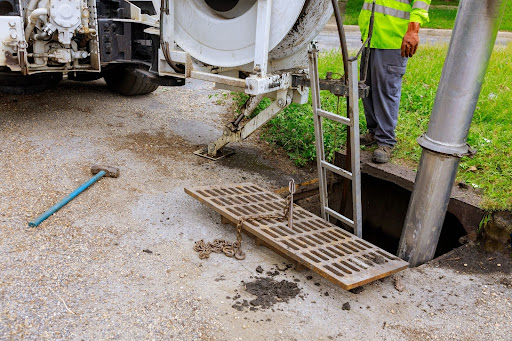If you’ve ever had slow drains or foul smells in your yard, the culprit might be closer to home than you think: Tree Roots Problems in pipes. In Cypress, TX, yards, those big shade trees can quietly wreak havoc underground, leading to expensive sewer line repair. Especially when roots find their way into cracks in your sewer main.
Homeowners in Cypress complain about gurgling toilets, soggy spots in the lawn, or even sinkholes, only to learn that it’s tree roots lodged in their sewer line. Let’s chat about why those roots are such trouble, the warning signs, and what you can do about it, without any robotic tech talk.
How Tree Roots Problems End Up in Your Sewer Line
Tree roots naturally seek moisture and nutrients. If your sewer pipe has even a tiny crack or loose joint, roots are drawn toward it. That small leak becomes a welcome oasis. Over time, those roots expand inside the pipe, forming tangles that block flow, crack lines, and even collapse pipes. Clay or older cast‑iron pipes common in older Cypress homes are especially vulnerable .
Warning Signs in Your Yard
Slow drains or backups
If water drains slowly from sinks, showers, or tubs in multiple spots, tree roots in the main sewer line could be to blame .
- Step 1: Turn off the water supply: Find the valve behind your toilet and twist it clockwise until it stops. Flush to drain the tank.
- Step 2: Remove the tank lid: Set it aside carefully; it’s porcelain and can crack easily.
- Step 3: Check the flapper: Push down gently. If the noise stops, replace or clean it.
- Step 4: Inspect the chain: Make sure it has a slight slack. Adjust length if needed.
- Step 5: Adjust the float: Lower it so the water stays below the overflow tube.
- Step 6: Replace the fill valve if needed: If all else fails, the fill valve may be bad. A replacement only takes about 20 minutes and can fix the issue for good.
Gurgling sounds
Hear bubbles or gurgles when flushing or draining? That air trapped by roots is a red flag .
Foul smells outside
If sewage odors drift across your lawn or near planting beds, roots may have ruptured the pipe, letting gas escape.
Wet patches or sinkholes
Moist or marshy spots in your yard, or even a small sinkhole, can signal sewage leaking from a root‑damaged pipe .
Unusually lush grass
Tree roots clogging a sewer line might cause water to seep into the soil, nourishing greenery in weird spots .
Damage Tree Roots Cause in Cypress Sewer Lines
Once roots make it in, cleanup isn’t just about cutting them out. They can expand over time, pushing against pipe walls and creating cracks or causing entire sections to collapse. That leads to sewer backups, yard erosion, possible effect on your home’s foundation, and yes, a costly sewer line repair in Cypress, TX. Older materials like clay or Orangeburg pipes are more prone to that kind of damage .
Fixing the Problem: What Works in Cypress, TX
1. Camera inspection first
In Cypress, most trusted plumbers will run a camera through your main sewer line. That lets them see root intrusions, cracks, or voids, without tearing up your yard.
2. Cutting and clearing roots
Once identified, they use mechanical root cutters or high‑pressure hydro‑jetting to slice through roots and flush them out. Hydro‑jetting is especially effective at cleaning the entire pipe .
3. Chemical or foam root treatments
Foaming root killers coat roots inside the pipe and prevent fast regrowth. Copper sulfate, salts, or foaming agents are common, but they’re short‑term fixes unless pipes are repaired .
4. Pipe repair or replacement
If roots have caused serious damage, then sewer line repair in Cypress, TX, may mean trenchless lining or bursting. In trenchless lining, a resin‑coated liner is inflated inside the old pipe and cures in place to seal leaks. Bursting replaces the old pipe altogether, all with minimal digging.
Preventing Future Root Problems
Choose safe tree species.
Plant away from pipelines. Trees like willow, silver maple, and poplar have aggressive roots. Instead, pick non‑invasive types and keep at least ten feet between trees and your sewer main.
Use root barriers
Consider installing physical barriers made of plastic or metal between trees and sewer lines. Chemical barriers, low‑release copper sulfate or potassium compounds, can slow root growth.
Upgrade vulnerable pipes
Replacing aging clay or cast‑iron with PVC or seamless polyethylene cuts off root entry points. These newer pipes are much less likely to leak.
Schedule regular inspections
Have a licensed plumber perform a video camera inspection every year or two. Early detection means cheaper fixes before roots fully invade and cause clogs.
Why Cypress, TX Homeowners Should Act Now
Houston area soil and mature landscaping can make root problems more common. Extended dry spells make tree roots even more aggressive; they search deeper underground for moisture and often find leaking pipelines instead. Acting quickly avoids backups inside the house and avoids damage to your foundation or lawn.
The Customer Experience: Real Stories
Some homeowners in Cypress had slower drains and damp spots in their yard. They called a local plumbing team, got a video inspection the same day, and had clear, honest advice. One reviewer said they had a quote within 24 hours, and the root‑cutting and lining job was done with minimal disruption. No fluff, just results, and they could finally stop worrying about backups.
When to Call On Point Plumber
If you’re seeing warning signs or planning new trees in your yard, reach out to On Point Plumber, a Cypress, TX expert in sewer line repair, Cypress, TX, and outdoor plumbing in Houston. We offer free or affordable camera inspections, honest quotes, expert hydro‑jetting, and trenchless repairs.
Check out our sewer and drain services, and if you want to ask questions or set an appointment, head over to our contact page. We’ll walk you through it, without tech‑speak or pressure.
Quick Guide
Symptom or Prevention Tip | What It Means |
Slow drains in multiple fixtures | Likely main sewer blockage, possibly roots |
Gurgling toilets or drains | Trapped air from partial intrusion |
Foul outdoor odors | Sewer gas escaping, pipe likely cracked |
Wet grass patches or sinkholes | Sewage is leaking from root damage |
Camera inspection reveals roots | Next steps: root cutting or pipe repair |
Hydro‑jetting or root cutters | Remove roots and clean the pipe in one go |
Trenchless lining/bursting | Repair or replace damaged pipe with minimal yard disturbance |
Root barriers and safe tree planting | Prevent roots from reaching pipes |
Regular professional inspection | Catch problems early, reduce cost, and minimize lawn disruption |
Don’t Let Tree Roots Wreck Your Sewer Line in Cypress, TX
Tree roots invading sewer lines in Cypress yards are more than just a nuisance; they’re a common cause of backups, foul odors, lawn damage, and costly sewer line repair in Cypress, TX projects. By recognizing warning signs early, scheduling camera inspections, choosing effective removal methods like hydro‑jetting, and preventive landscaping, you can avoid bigger headaches down the line.
If you’re seeing slow drains, damp spots, or bad smells, it might be time to take that step and call in professionals. On Point Plumber knows the local soil, tree species and has the tools to fix the issue with minimal fuss, no generic claims, just clear answers and solid results.
Frequently Asked Questions
How far should I plant trees from my sewer line?
At least ten feet away is smart. Choosing slow‑growing, non‑invasive species makes it safer.
Can I use root‑killer chemicals myself?
You can, but these treatments only delay regrowth. They are no substitute for proper inspection and repair.
How often should I get a sewer camera inspection?
Every year or two is ideal for detecting early root intrusion.
What’s trenchless sewer repair?
It’s a way to fix or replace sewer pipes without digging trenches. It repairs wall leaks or bursts out the old pipe and pulls in a new one .
Can hydro‑jetting damage my pipes?
When done by trained professionals, hydro‑jetting is safe and effective. It clears roots and residue without harming most pipes.

